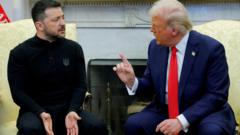The US has officially paused some shipments of military weapons to Ukraine, as confirmed by a White House spokesperson, Anna Kelly. This decision comes as Russia intensifies its offensive against Ukraine, with US officials citing a need to prioritize national interests. The measure follows a Department of Defense review aimed at evaluating military assistance to various allies.
Since the outset of Russia's full-scale invasion in February 2022, the US has provided Ukraine with substantial military support, amounting to tens of billions of dollars. However, this assistance has raised alarms within the Trump administration regarding the potential depletion of US military stockpiles. Specific shipments affected by the suspension remain undisclosed, although reports indicate that critical air defense missiles and precision munitions are among the weapons impacted.
Elbridge Colby, the Undersecretary of Defense for Policy, reassured that the Department of Defense continues to offer robust military aid options to the President while reassessing its strategy to balance ongoing assistance with the readiness of US forces for administration defense priorities. He noted the importance of adapting military support without compromising US national security.
This development follows a recent meeting between US President Donald Trump and Ukrainian President Volodymyr Zelensky at a NATO summit in the Netherlands, where discussions about potential additional support, including extra Patriot anti-missile systems, were reported. Although both leaders appeared cordial at the summit, their previous encounters have been marked by tension, particularly regarding military assistance.
As the situation on the ground remains critical, with Russia executing one of its most significant aerial offensives against Ukraine recently, the timing of the US's decision raises concerns about the impact on Ukraine's defense capabilities. Reports indicate that Russia has made gains in controlling approximately 20% of Ukrainian territory, including Crimea, which was annexed in 2014.
As global tensions persist, the ramifications of the US's military aid policy may reshape the dynamics of support for Ukraine and the wider geopolitical landscape in Eastern Europe.
Since the outset of Russia's full-scale invasion in February 2022, the US has provided Ukraine with substantial military support, amounting to tens of billions of dollars. However, this assistance has raised alarms within the Trump administration regarding the potential depletion of US military stockpiles. Specific shipments affected by the suspension remain undisclosed, although reports indicate that critical air defense missiles and precision munitions are among the weapons impacted.
Elbridge Colby, the Undersecretary of Defense for Policy, reassured that the Department of Defense continues to offer robust military aid options to the President while reassessing its strategy to balance ongoing assistance with the readiness of US forces for administration defense priorities. He noted the importance of adapting military support without compromising US national security.
This development follows a recent meeting between US President Donald Trump and Ukrainian President Volodymyr Zelensky at a NATO summit in the Netherlands, where discussions about potential additional support, including extra Patriot anti-missile systems, were reported. Although both leaders appeared cordial at the summit, their previous encounters have been marked by tension, particularly regarding military assistance.
As the situation on the ground remains critical, with Russia executing one of its most significant aerial offensives against Ukraine recently, the timing of the US's decision raises concerns about the impact on Ukraine's defense capabilities. Reports indicate that Russia has made gains in controlling approximately 20% of Ukrainian territory, including Crimea, which was annexed in 2014.
As global tensions persist, the ramifications of the US's military aid policy may reshape the dynamics of support for Ukraine and the wider geopolitical landscape in Eastern Europe.




















